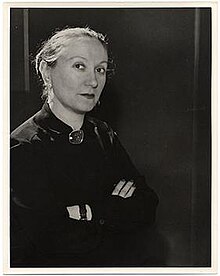Helen Gerardia
Helen Gerardia | |
|---|---|
 Helen Gerardia, ca. 1956, photographed by Oliver Baker | |
| Born | 1903 |
| Died | 1988 (aged 84–85) |
| Nationality | American |
| Known for | Painting |
Helen Gerardia (1903-1988) was a Russian-born American painter.
Early life and education
She was born in Ekaterinoslav, Russia in 1903.[1] She immigrated to the United States in the 1940s to study under Hans Hoffman.[2]
Career
During her career, she painted and also engaged in lithography and etching. She eventually founded the Gerardia Workshop, where she taught a variety of mediums.[2]
From 1967 until 1969, she was president of the American Society of Contemporary Artists.[3] She exhibited her work at the Metropolitan Museum of Art, where her work was described as showing "good arrangement," and being "visually pleasing." She was called an "industrous artist," by one critic.[2]
Later life and legacy
She died in 1988.[1]
Work
She was primarily a painter, and participate in the Abstract expressionist movement early in her career while studying under Hans Hoffman. In the early 1950s, she leaned more towards the Cubism movement. Gerardia used geometric shapes in much of her work. She used primarily black and white in her work. She started incorporating more color starting in 1959, to her paintings, including lavendar, which renders heavily into her works during the early 1960s. She emphasized negative space frequently in her work, which was featured prominently due to her choice use of color.[2]
Notable collections
- "Ballerina" - 1951, oil on canvas, Smithsonian American Art Museum[4]
References
- ^ a b "Helen Gerardia". Smithsonian American Art Museum. Smithsonian Institution. Retrieved 2 January 2016.
- ^ a b c d "Helen Gerardia ( 1903 - 1993 )". Butler Art Collection. Retrieved 2 January 2016.
- ^ "Helen Gerardia". Asheville Art Museum. Retrieved 2 January 2016.
- ^ "Ballerina". Smithsonian American Art Museum. Smithsonian Institution. Retrieved 2 January 2016.
